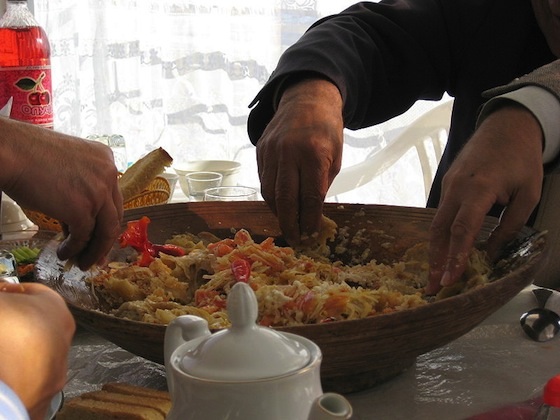Africans, Arabs and Indians (to name only a few) describe in rhapsodic terms the advantages of eating with their fingers: the sensuous connection to the food, the feeling of sharing and community, practicality (in that it’s easier to pluck that last bit of meat off the bones) avoiding waste, even a lingering aroma on the fingers to sustain the memory of a marvelous meal.
After reading scores of impassioned comments that the above mentioned article garnered, I felt compelled to conduct my own interviews to get a first-hand perspective on this cultural divide, followed by a hands-on lesson (see video clip below.)
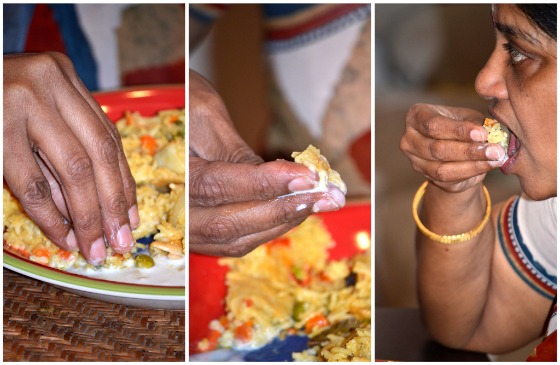
photos courtesy of Vijitha Shyam of Indian food blog Spices and Aroma
Vinita Chopra Jacinto grew up in Northern India and is now a chef instructor at the California Culinary Academy in San Francisco. She feels strongly that Indian food tastes best when eaten with one’s fingers. She tells me that Indians eat with their hands because they believe that food is, “more than just protein, carbs and fat it nourishes the mind, intellect and spirit. Eating should be sensual and mindful, employing all the senses: sight, smell, sound, taste and touch. Using your hands gives you a tactile connection with your food.”
Jacinto clarifies some regional differences, “In the North, where breads are commonly consumed, you tear a piece of bread and wrap it around your food. While, in the South, rice is combined with curries, and each mouthful offers a unique blend of flavors. Traditionally in Southern India, plates are made of disposable, recyclable, banana leaves. Using a knife and fork on a banana leaf would shred your plate.”
Significantly, all cultures that shun silverware maintain a set of rules for eating with the hands. Before the meal, the hands must be washed, wiped or even rubbed with sand, as desert Arabs do. But the foremost rule is that only the right hand is employed for eating.
“The left hand is never used for that,” Jacinto says, “It is considered unclean.” In principle, at least, this is because the left hand is saved for bodily cleaning. Another taboo Jacinto cautions against is jutha, or double dipping your bread into a communal dish of food.
“The secret to gracefully eating with your fingers,” Jacinto advises, “is to use your thumb. For example, a small amount of rice is formed into a little pile on your plate, blended with one or more bits of curried lentils, vegetables, meat or fish, and then picked up with a twist of the wrist, held onto by the fingers and maneuvered right up to your mouth. But don’t put your fingers into your mouth.” she instructs, “Just use your thumb to push the food inside.”
Fharzana Elankumaran, founder of I Heart Curry, where she teaches Indian cooking classes, also grew up eating with her hands in Bangladesh. “I appreciate this way of eating because you have more control over your food,“ she says. “For example, if you’re eating fish or chicken, you don’t have to worry about cutting with a knife around the bones. When you use your fingers, you can get every last bit of meat and so waste less. It’s an expression of the great respect we have for the food.”
In her Indian cooking classes, Elankumaran encourages students to eat with their hands, but finds that it may be a challenge for first-timers. “ Sometimes my students tell me their hands get tired, because they are using a whole new set of muscles.”
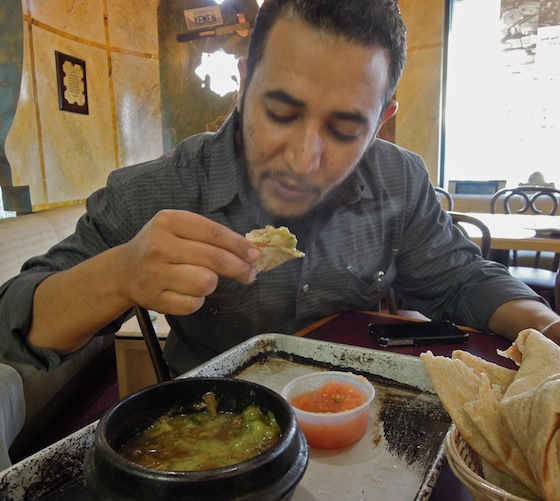
Yemeni dish at Oasis Market and Restaurant
On a shopping trip to Oakland’s Oasis Market and Restaurant, I spy manager Rassam Sharif eating his lunch by hand. It’s a Yemeni specialty, fahsa (cooked boneless beef topped with whipped fenugreek, with a salsa-like sauce). Sharif kindly demonstrates his technique: he tears off a bit of tandoori bread, dips it into the meat and salsa, and brings it to his mouth with 3 fingers. Sharif prefers eating by hand because, he says, “You have more connection to your food. With a spoon, it’s just like shoveling something into your mouth to get full. In Islam, we are taught that the Prophet said to eat from your own side of the dish, slowly, with the right hand, just until you are not hungry. It makes you take your time and be mindful of what you’re eating.”
Enough talk, I decide, it’s time for me to get some hands-on tutoring.
Luckily, my request for cross-cultural dining instruction interests Mostafa Raiss El Fenni, owner of Berkeley’s Sahara Home Décor. He invites me to stay for lunch and we sit on intricately carved and painted chairs amid his stunning collection of Moroccan carpets, ottomans, embroidered textiles, brass lanterns, conical clay pots and delicate tea glasses.
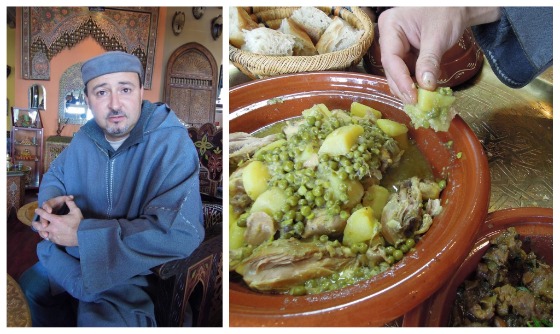
Mostafa Raiss El Fenni -- Moroccan food
Raiss El Fenni, a former Cal student and chemist, whose shop promotes the works of artists from his homeland, tells me, “Eating with your hands is about sharing,” and as the youngest in a family of 12 children, he got a lot of practice doing that. There is an intimacy formed when you all eat from the same dish dipping in small pieces of bread, he explains. “ And if you find a piece of meat close to you that’s especially good, you can share it with your neighbor.”
“Does each person take the piece of meat and bread onto their own plate?” I ask.
“We don’t have individual plates. We are a very collective society. But if we invite guests over who are not familiar with this way of eating, we show them how it’s done.”
Watch my lesson in eating with the hands, Moroccan style:
In the college dorm, it was a bit of culture shock for Raiss El Fenni that each student ate his own sandwich. “I couldn’t get used to eating by myself. So, I just waited with my food until they were done, and then said, “Hey, want to share? Eventually they got the idea and would offer to share some of their sandwiches with me too.”
Raiss-El-Fenni also hosts Moroccan parties in colorful Berber tents set up outside his shop. Parties range from mint tea and pastries to an all-out catered feast with live music and belly dancers. And of course, he will encourage your guests to eat with their hands for the true Moroccan experience.
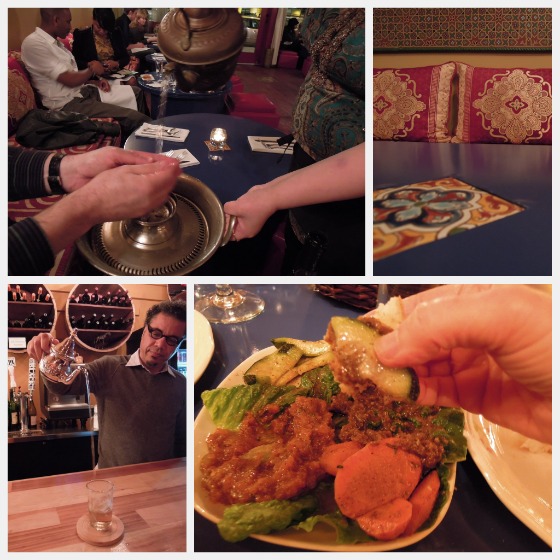
Tanjia Moroccan Restaurant
After my tasty lesson, I invite my husband out for a Moroccan meal and tell him I’ll show him how to eat with his hands, so we head over to Tanjia, an Oakland Moroccan restaurant we haven’t yet tried.
We enter the lovely blue and red interior with low couches that let you sit close to your dining companion. But I am disappointed to see the tables set with forks and knives. When I tell the server we hoped to eat in Moroccan fashion, she gladly takes away the silverware and returns with a pot of water and washes our hands.
The first course is an assortment of delicately spiced salads: carrots, eggplant, cucumbers, tomato and bell pepper. Easy to scoop up with chunks of home baked bread. But with the arrival of the lamb and eggplant and chicken with honey and prunes, which are so meltingly tender you can tell they have cooked slowly for hours, my husband chickens-out of the hands-on approach and, to keep him company, I ask for two forks. It’s not so easy to change a lifetimes's eating habits.
Owner Jamal Zahid recently took over the restaurant from his brother, Said who started Tanjia in 2000. It has always been a “silverware optional restaurant” but seeing the reaction of a younger generation of customers not used to the traditional Moroccan way of dining sans utensils, Zahid decided-- as an act of hospitality to his guests-- to set the table with forks and knives, a reversal of his brother’s default setting. Personally, Zahid favors eating with the hands as a way to feel connected to the food and savor the meal slowly.
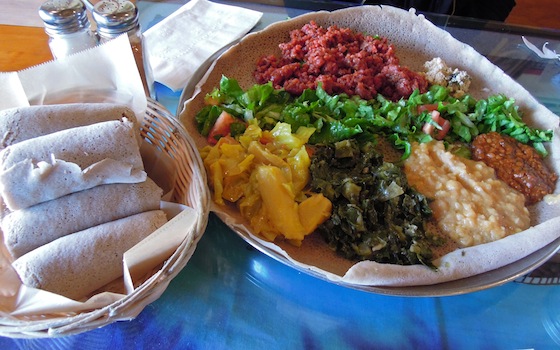
Ethiopian platter and injera - Cafe Colucci
At Oakland’s Café Colucci Ethiopian restaurant, by contrast, forks are nowhere in sight. Injera, the spongy, slightly sour, crepe-like bread made from the teff grain, functions as tablecloth, plate and utensil and the food is served family style, atop a large injera circle. “Eating is almost a sacred ritual,” says owner Fetlework Tefferi, whose award-winning restaurant just celebrated its 20th year. Besides the rules of hand washing and right hand only, she adds another from her native Ethiopia, “Once the tray of food is laid on the table, no one rises until all are done and the tray removed. We chew slowly, with closed mouths and a calm dignity. The food is sacred. It’s not polite to rush through your meal.”
Again, eating with the hand is more than just a mechanism to get sustenance into the mouth. “On certain occasions,” explains Tefferi, “we feed each other by hand, it’s called goorsha and it’s a loving act, an endearment. You might feed a child who is not eating enough or a guest you are entertaining. But if I were to make a bite for a man, “she chuckles,” I need to make sure it’s a big, well-packed roll of injera. I guess it’s a macho thing.” She adds, “We usually don’t eat alone. If you are in a restaurant in Ethiopia, for example, and the people at the next table get served first, they will probably ask you to join them or at least take a few bites with them. That kind of sharing is what holds us together.”

Tefferi demonstrates how to tear off a small square from the rolls of injera in the basket. She describes the technique as “wrap and roll.” You lay your piece of injera over some food and use all your fingers to gather up the filling and twist it into a little packed pouch, which you may dip into several different dishes on the tray. Our platter today has collard greens seasoned with black cumin, cabbage with carrots, potatoes with ginger, garlic and turmeric, lentils in red berbere sauce, yellow split peas in turmeric sauce, Ethiopian cheese and kitfo, a highly seasoned raw meat dish.
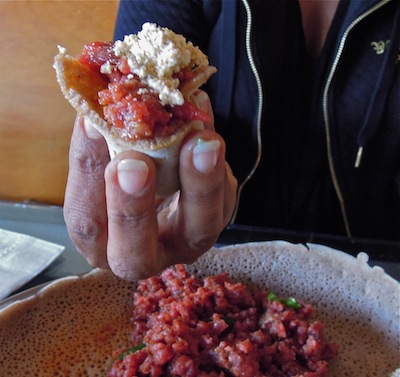
“Children are taught to make a bite of food that’s just big enough to fit in their mouth all at once, without stuffing their cheeks and to eat only with their right hands.” Tefferi remembers her mother training her left-handed brother by having him sit with his left hand behind his back.
“In the restaurant, we get 97% American diners. If they ask for silverware, I tell them it will be $10 extra,” teases Tefferi, with a twinkle in her eye, “ I just want them to try eating with their hands.” This gracious cultural ambassador wants to encourage more people to appreciate the 3000-year old cuisine of her homeland. “We need to revisit the way people used to eat; how much they cared and believed that whatever they put into their mouths was sacred,” says Tefferi. “The aroma is important too. Even after you wash up at the end of the meal, the scent of the food remains on your hand. Later, you might hold up your hand to someone else and say “Smell my hand, see how good the food was!”
